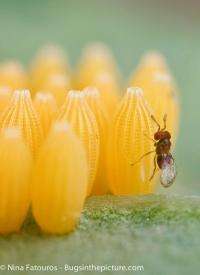Flight Artists film smallest insect in flight

The Flight Artists team from Wageningen University, the Netherlands, has been the first to make high-speed camera footage of parasitic wasps of about 1 mm wingspan.
The team made films of the tiny flying insects at 22,000 frames per second. That is almost 900 times faster than a TV-screen can show. In the time between two TV images, the wasp has beaten its wings 14 times.
This is the first time the flight behavior of the parasitic wasp is observed, which is used as biological crop protector that kills the eggs from which harmful caterpillars grow. It was known that parasitic wasps hitchhike on top of larger insects, such as butterflies, but until now nobody had seen how the wasps were able to fly to the butterflies and their eggs.
The high speed movies show how the parasitic wasp jumps up into the air, elegantly flaps around, and then somehow lands – the insect sometimes boldly lands face-first. Nevertheless the wasps are able to fly over some distance with their wings beating – as the new images reveal – at 350 strokes per second. The insect are estimated to weigh only about 1/40,000th of a gram, but it is not the smallest known insect; the Tanzanian parasitic wasp spans less than 0.3 mm, which is about 3 times smaller. This extremely small insect cannot be bred so far, therefore it can only be found and filmed in the wild.
The movies are made by researchers at Wageningen University, part of Wageningen UR, using a Phantom high-speed camera. This same camera will be made available to the nature amateurs, artists, and hobby photographers that applied to participate in the Flight Artists project. The project aims at involving the general public in scientific research into the way in which birds, bats, insects, and even seeds fly. They will use the newest high-speed video techniques to shoot images of fliers in Nature that fascinate them. A range of special lenses, lamps and field facilities is available to record details that are invisible to the naked eye; invisible, either because they are too small or, more likely, because they are too rapid for the observer. So far, 54 participants have been trained to take this extraordinary camera into the field.
The Flight Artist team is the 2010 winner of the national Netherlands contest for academic research groups to stimulate science understanding and participation for the layman.
Provided by Wageningen University

















